May 5, 2021
By Claudia Boyd-Barrett
Photos by Martin do Nascimento for the California Health Report
A street in the Kern County community of El Adobe, California.
When Ramona Hernandez turns on her kitchen faucet in El Adobe, an unincorporated town just a few miles southeast of Bakersfield, the water that splashes out looks clean and inviting. But she doesn’t dare drink it.
“You worry about your health,” she said in Spanish as she sat in her tranquil front yard one morning early this spring, her elderly mother-in-law working in the garden behind her.
“I’m scared,” Hernandez said, “of getting sick from the water.” Drinking the tap water in this tiny community of dusty ranches and unpaved roads could expose Hernandez to arsenic. So, for years, she and her husband, Gerardo, have shuttled twice a week to the nearby town of Lamont to load up on bottled water. At a cost of about $80 a month, it’s enough for drinking and cooking. If they had the money, Hernandez, 55, would buy bottled water to shower with and use for her chickens. But given her husband’s salary as a farmworker, she says, that’s not a realistic option.
Like more than 300 communities across California, El Adobe lacks safe drinking water. Since 2008, the arsenic levels in one of its two wells have regularly exceeded the safety standards set by federal and state authorities, often by more than double. Long-term exposure to arsenic in drinking water is linked to diabetes, high blood pressure and cancer.
Contaminated drinking water affects an estimated 1 million people in California, many of whom rely on private wells or small community water systems like El Adobe’s. A majority of these residents live in the Central and Salinas valleys. These are largely low-income, rural and Latino communities, where lack of access to clean water exacerbates the health disparities that already exist due to structural inequities. Since 2012, California law has recognized that access to safe and affordable water is a human right, but action has lagged behind the language.
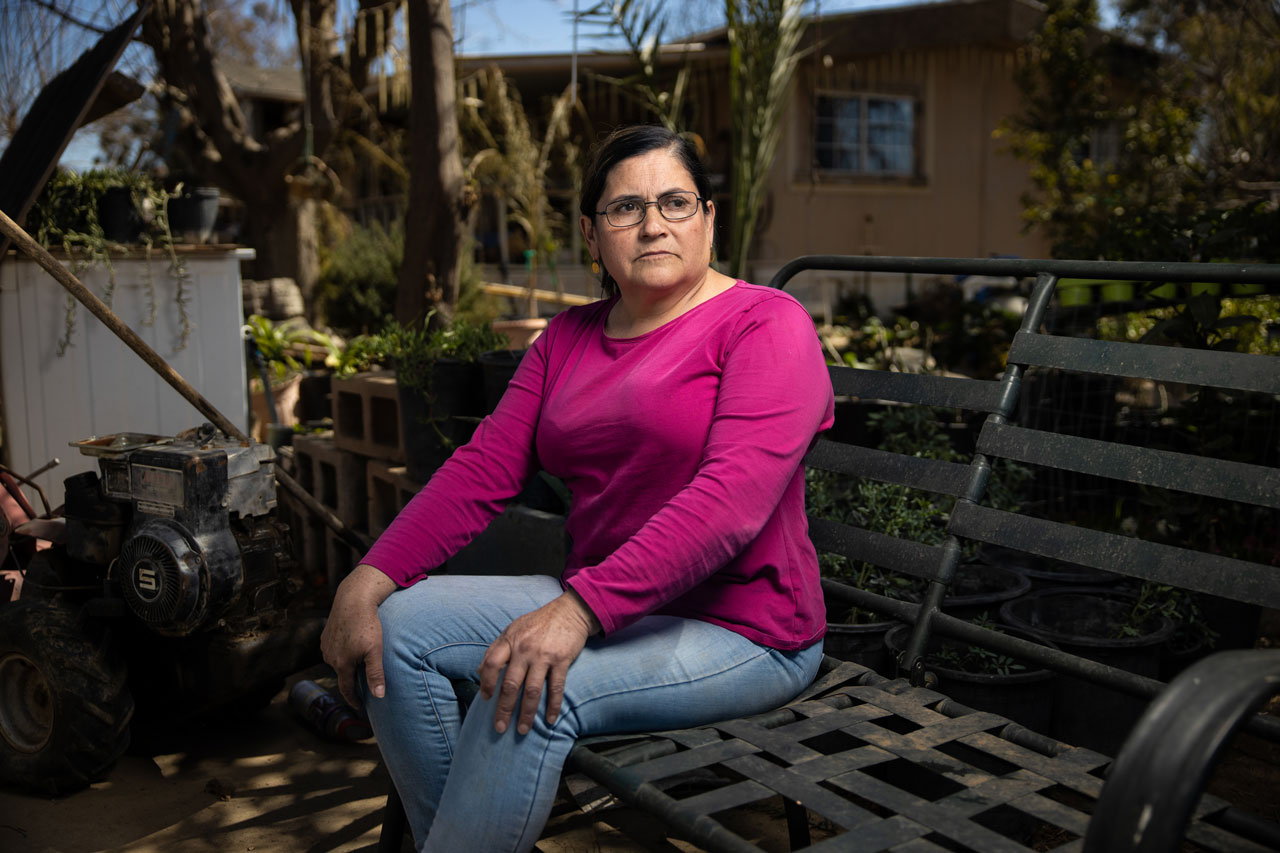
Ramona Hernandez in her garden in El Adobe, California. Hernandez worries that contaminated tap water in the community could make her sick.
Arsenic levels in El Adobe’s other well are currently deemed safe, but the well can’t provide enough water to meet year-round demand. That means that many residents of the unincorporated town, including the Hernandezes, continue to pay for water they can’t drink. The El Adobe Property Owners Association charges households $125 a month for tap water, money that also covers streetlights and road maintenance (although only one road is paved). Most residents also buy bottled water at the store. Others take their chances and drink the tap water despite the risks. Many townspeople are low-income farmworkers and retirees, and buying bottled water is a significant expense.
“I can’t afford bottled water all the time,” said Kyle Wilkerson, 40, a father of three who lives on a fixed disability income. He’s also president of the El Adobe Property Owners Association, a small cadre of community members who manage the town’s water infrastructure almost entirely as volunteers.
Wilkerson said he worries about his own health as well as that of his family. “But what am I going to do?” he said. “You get to the point of, it is what it is.”
And indeed, residents in towns like El Adobe have few options. Arsenic can be removed from water, but it’s prohibitively expensive for most small towns. An arsenic treatment facility requires millions of dollars to build and another $100,000 or more per year to operate, said Chad Fischer, an engineer who works at the California Division of Drinking Water’s district office in Visalia, which regulates water in the region.
Kyle Wilkerson, President of the El Adobe Property Owners' Association at the Well #1 in El Adobe, California. The well is one of two in the community, and was built in 1967.
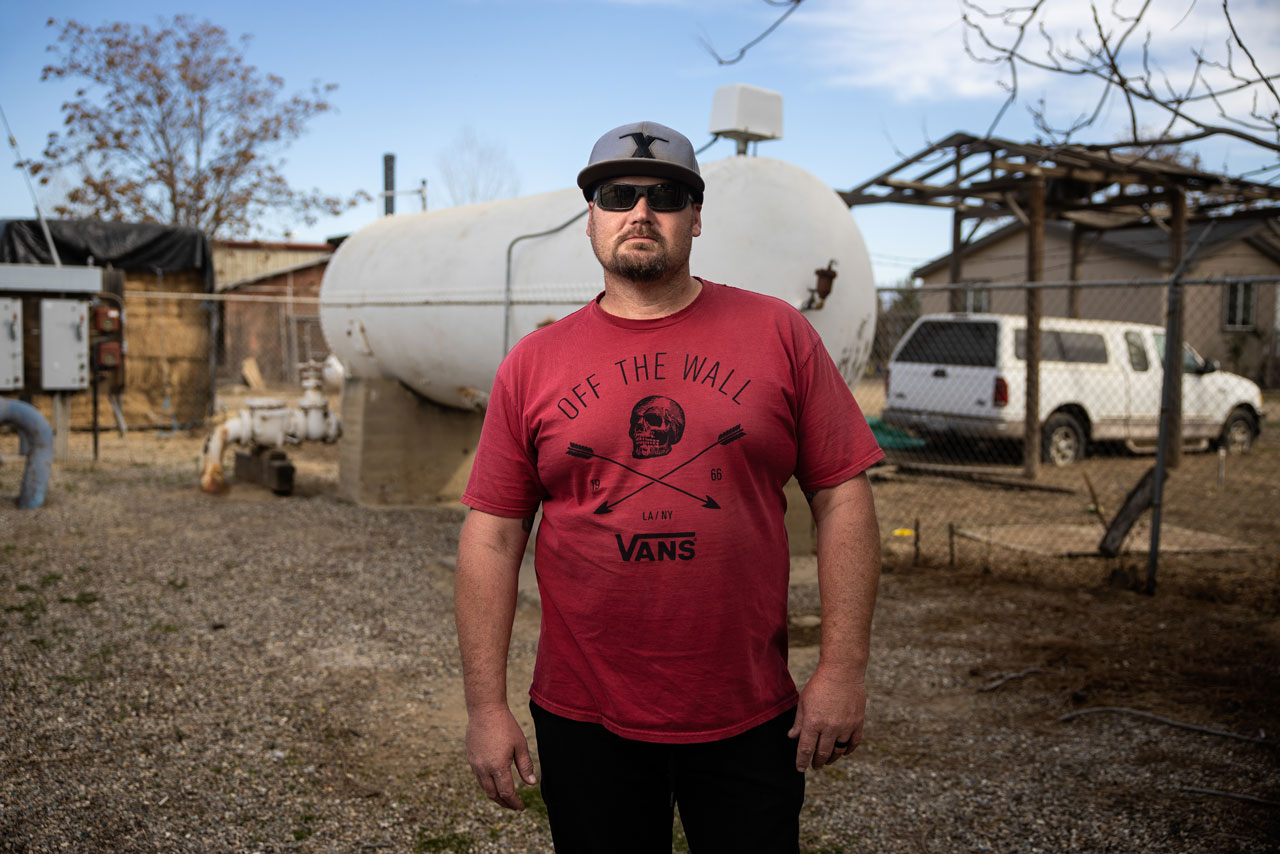
El Adobe is so small — just 83 homes — that if community residents split the cost of a treatment system, they’d spend tens of thousands of dollars each and face dramatically increased water rates. “The math is awful,” Fischer said. “It ends up being unaffordable.”
It’s possible for individual users to install an advanced filtration system, such as reverse osmosis, in their homes, usually under the sink, to remove arsenic. But these systems can cost hundreds of dollars to install and maintain. Some small water systems do install these in people’s homes, passing on the cost to consumers, but the state considers this a temporary fix. Inexpensive pitcher-type filters do not remove arsenic.
A permanent solution was supposed to be coming for El Adobe. In 2013, with funding from the California State Water Resources Control Board, El Adobe commissioned a report that concluded that the best option for the community was to connect with the larger water system in Lamont. According to Scott Taylor, general manager of the Lamont Public Utility District, the state promised to grant Lamont enough money to build the connecting pipeline, service lines and new wells needed to accommodate the increase in users and replace aging infrastructure.
“Eight years, it still hasn’t happened,” said Taylor. “I think it’s bureaucracy. For example, when we submit any kind of a document, a cost estimate, an engineering report … for whatever reason, it takes them two to three months to review it. If it took any of my staff a month to review a document, I don’t care if it’s 100 pages, I’d fire them.”
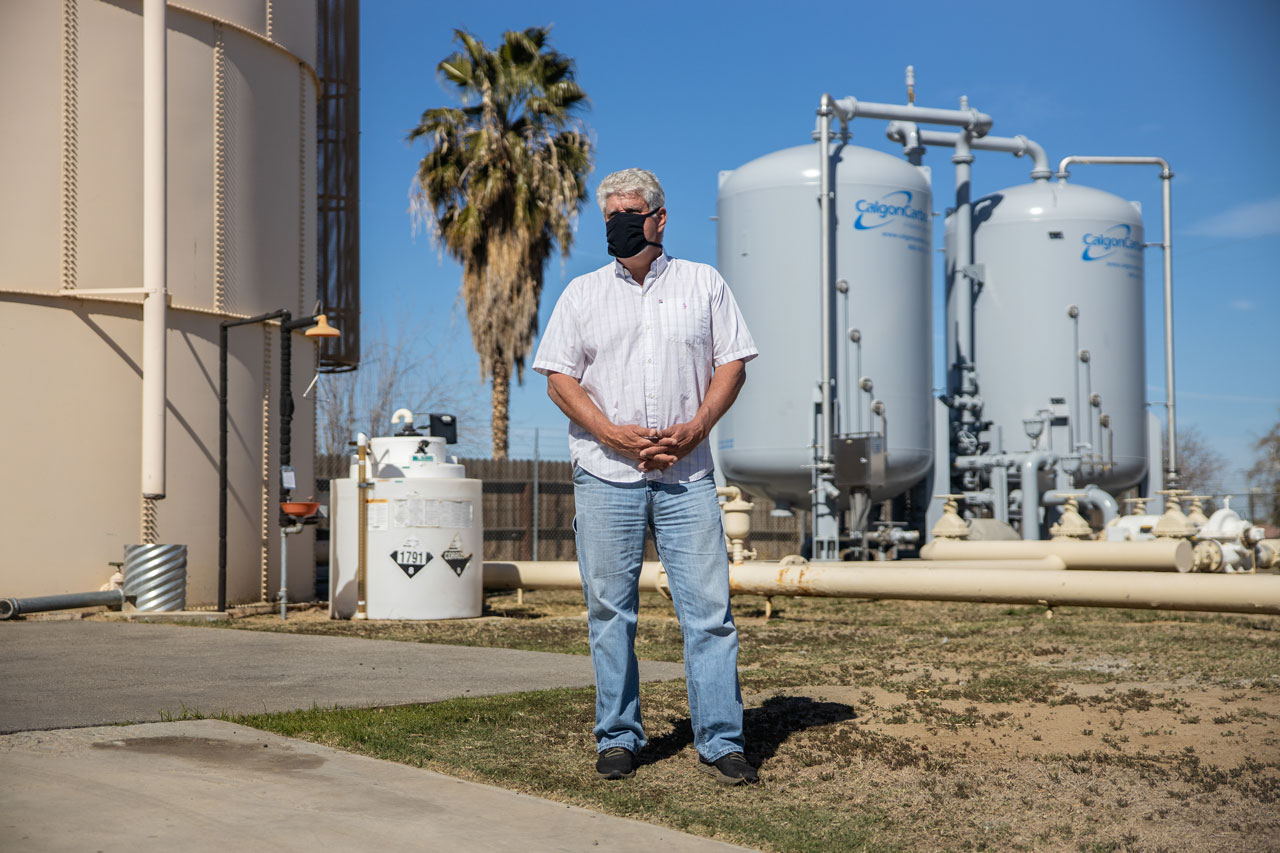
Scott Taylor, General Manager of the Lamont Public Utility District at Well #13 in Lamont, which recently broke down after installation of a $1 million treatment system for 123-TCP.
Blair Robertson, a spokesman for the California State Water Resources Control Board, said the state is still waiting for Lamont to purchase land for the new wells and drill test wells to see if water at the proposed sites is contaminated. There is currently no start date for the project, which is estimated to cost between $13 and 22 million and will likely be split into several construction phases. Formal state approval of the project will likely be in 2022, Robertson said, but there’s currently no timeframe for when El Adobe residents will have clean drinking water.
Planning and implementing a water system consolidation takes time, Fischer said, especially when the community, like El Adobe, is small and lacks a team of engineers and other professionals to manage the water supply. Lamont has its own water problems with contaminants and aging wells, which have added to the difficulties of the project, he said. Projects usually take five or more years to accomplish, he said, depending on their complexity. But it has already been eight years, and construction has yet to begin.
Beyond those delays, dozens of other communities in California are also waiting on construction projects for clean water. Approximately 110 other out-of-compliance water systems in the state are planning or considering consolidation with another system. Sometimes, the larger communities resist appeals to absorb the smaller systems because they fear it will increase costs and strain their own water supply, particularly as droughts continue. The state often offers financial incentives to encourage consolidation, and can mandate it, if necessary. Other times consolidation isn’t even an option because a community is too remote.
In 2019, California passed a law that established a program called Safe and Affordable Funding for Equity and Resilience (SAFER), designed to help fund water improvements for communities that struggle to provide clean water to their residents. The state water board is working to complete a needs assessment to determine which water systems need help and to what extent, according to a recent report by the state’s Legislative Analyst’s Office. However, the state is still “in the very early stages of implementation,” and “much work remains to be accomplished” before all Californians have access to safe and affordable drinking water, the report stated.
Cheryl Blackhawk, 67, and her husband Edward, 69, are fed up with not having safe water in El Adobe. They moved to the town four years ago from nearby Greenfield, seeing it as a quiet and affordable place to retire. At the time, the seller assured them the water connection to Lamont would happen within a year. They’re still buying water bottles by the caseload from Walmart.
Scott Taylor, General Manager of the Lamont Public Utility District at Well #13 in Lamont, which recently broke down after installation of a $1 million treatment system for 123-TCP.
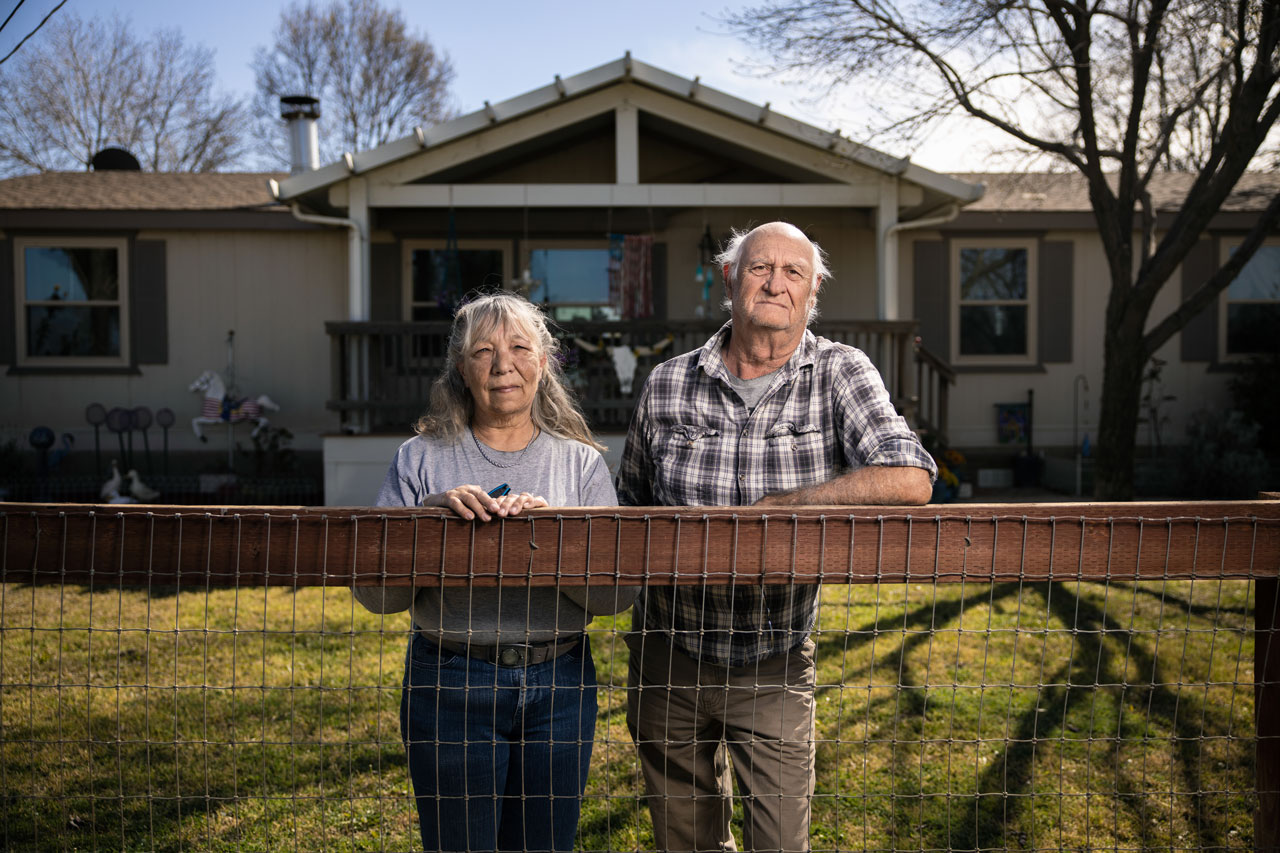
“You can’t go to the faucet to get water to drink,” said Edward Blackhawk. “You can’t cook.”
Contaminants aren’t the only problem. Like innumerable systems across California and the country, El Adobe’s wells, pipes, pumps and other water infrastructure are showing their age. El Adobe’s most critical well, the one without arsenic, was built in 1967, the same year Ronald Reagan became governor of California and labor activist Cesar Chavez initiated a nationwide boycott of the state’s table grapes. The community’s arsenic-laced well was built in 1985.
The life of a well depends on the chemicals in the local soil and water, and the quality of the well materials and construction, said Dave Warner, community development manager at Self-Help Enterprises in Visalia, which helps low-income communities access funding for water projects. But a well as old as 1967 “is really pushing it,” he said. Over time, the casing inside the well corrodes, and sand and other contaminants can get into the pump, causing it to fail. Still, drilling a new well costs more than $1 million, according to water officials. Securing state funding for it can take more than a decade, Warner said.
The precariousness of the situation is not lost on Edward Blackhawk. Without functioning wells and pumps, people’s faucets would run dry. Toilets wouldn’t flush.
“If these wells go down, we’re out of luck,” he said. “We’re out of water.”
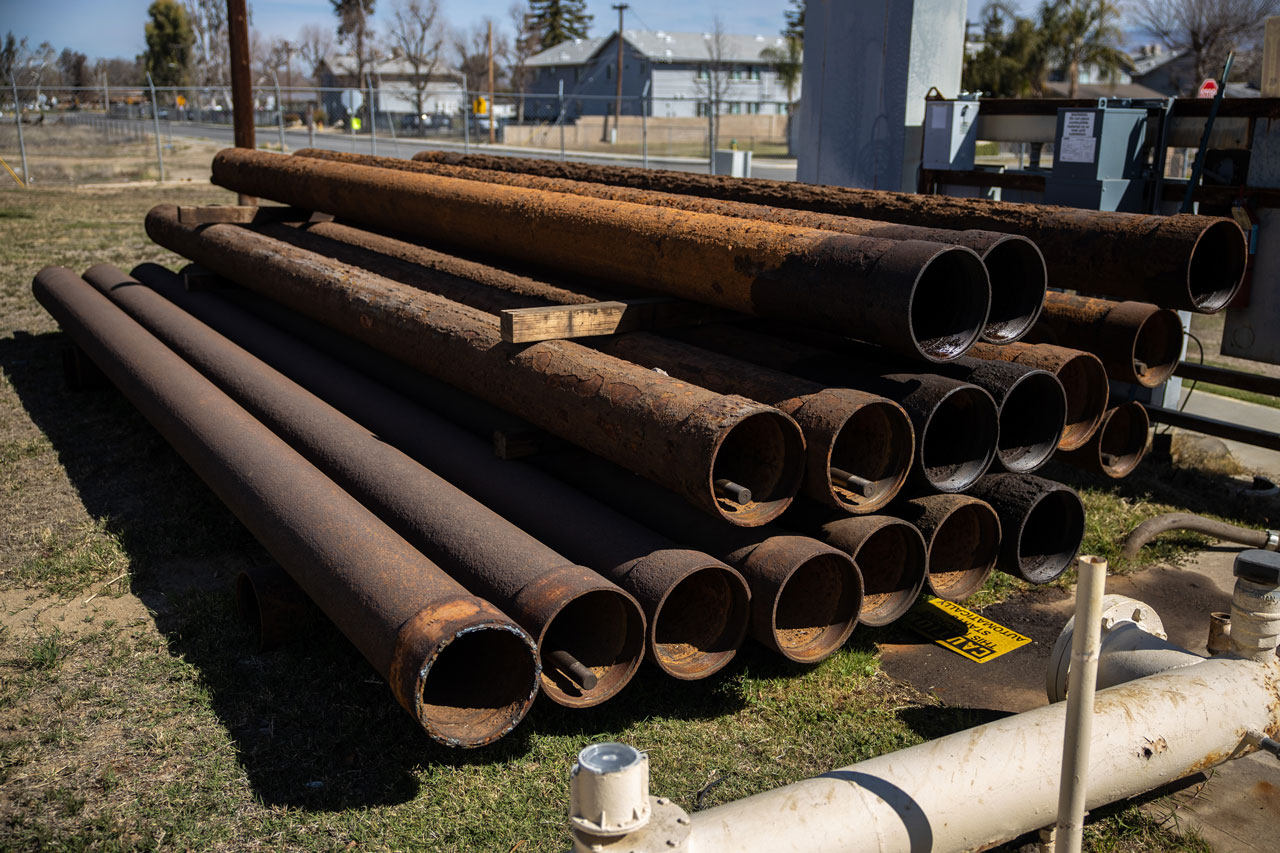
Defunct well water pipes stacked at the Lamont Public Utility District Well #13, which recently broke because of age. The district is waiting on funding to fix several of its wells so it can consolidate with nearby El Adobe.
Three miles down the road, Lamont has its own water struggles. Five of the town’s eight wells are contaminated with a highly toxic chemical called 1,2,3-trichloropropane, or 1,2,3-TCP. The chemical was added to soil fumigants used in agriculture during the 1940s through the 1980s. It persists in the environment indefinitely and is recognized as a carcinogen by the state of California. The state started regulating the chemical in drinking water in 2017, which meant communities like Lamont had to find a way to remove it.
We want solutions now. It’s a huge problem, and we have generations that have been condemned to this reality.
Susana De Anda, co-founder of the Community Water Center
Just like arsenic, 1,2,3-TCP is expensive to get rid of. A treatment system costs over $1 million per well, plus about $100,000 a year to change the filter, said Taylor. Lamont has installed treatment on four wells, using money from a settlement with Dow Chemical and Shell Oil, the companies allegedly responsible for the contamination. But two of the treatment systems are leased, and the utility district still doesn’t know how it will pay for them long-term. Two other wells still need 1,2,3-TCP and arsenic treatment systems, respectively.
Lamont’s population of 15,000 is almost entirely Latino, and many residents are farmworkers. The average per capita income is just over $13,000 a year. Plans to raise water rates last year to help cover some of the district’s expenses were delayed because of the pandemic. Even so, dozens of accounts fell into delinquency as people lost jobs and struggled to pay bills. The district is now short about $70,000 from delinquent accounts, Taylor said.
View of a farm in the agricultural community of El Adobe, California.
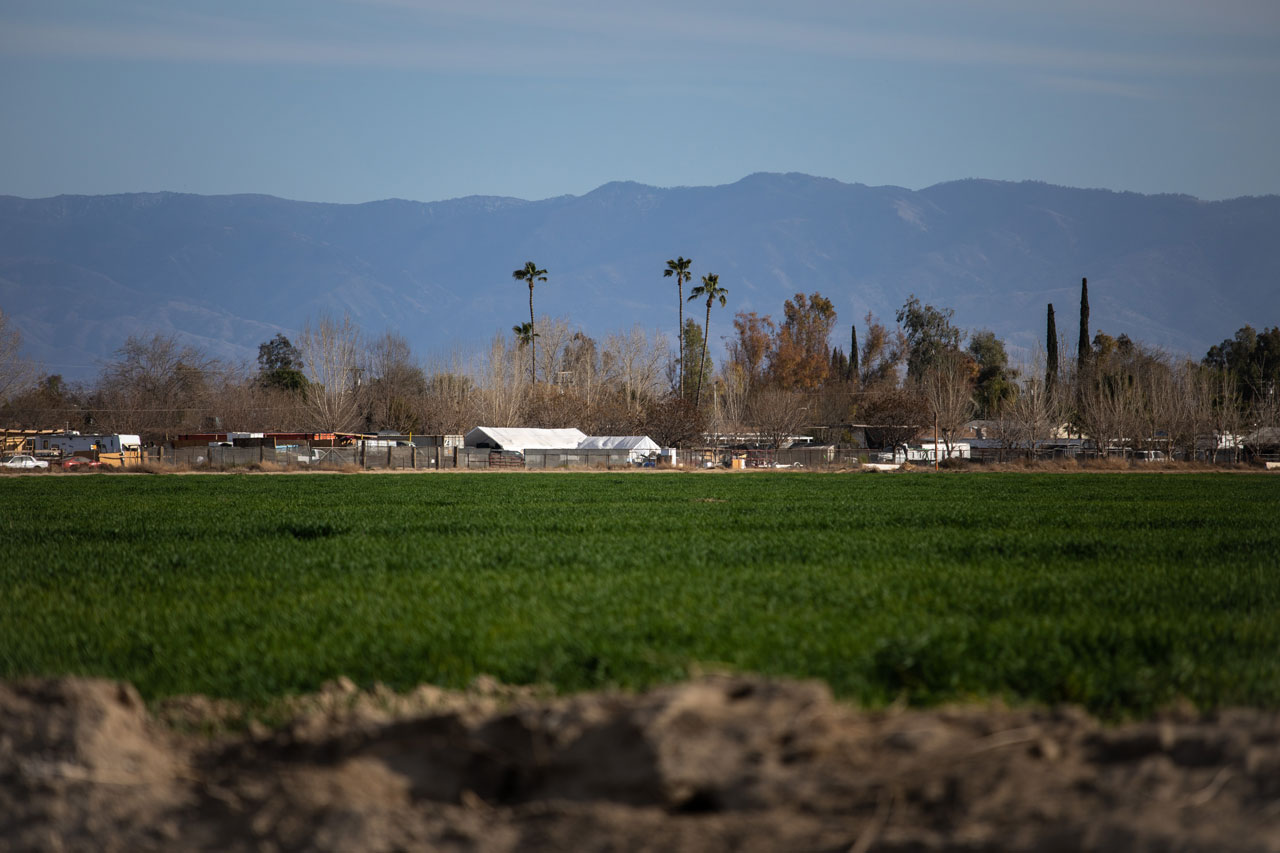
Lamont’s wells are also nearing the end of their lifespan. Last year, shortly after the district installed a $1 million filtration system for 1,2,3-TCP on a 60-year-old well, the well collapsed. Taylor said he “raised holy hell” with the state water board and obtained emergency funding to build a new well, which is now under construction. Another three wells need replacing, he said. Those new wells may also need treatment systems. Funding for that is supposed to be included in the consolidation project with El Adobe.
So far, Lamont has managed to provide clean water to residents, but that could change if another well breaks or demand increases enough to require making a contaminated well operational, said Taylor.
“It’s a little discouraging,” said district board member, Miguel Sanchez. “You’re trying to comply with all these regulations and the system is crumbling.”
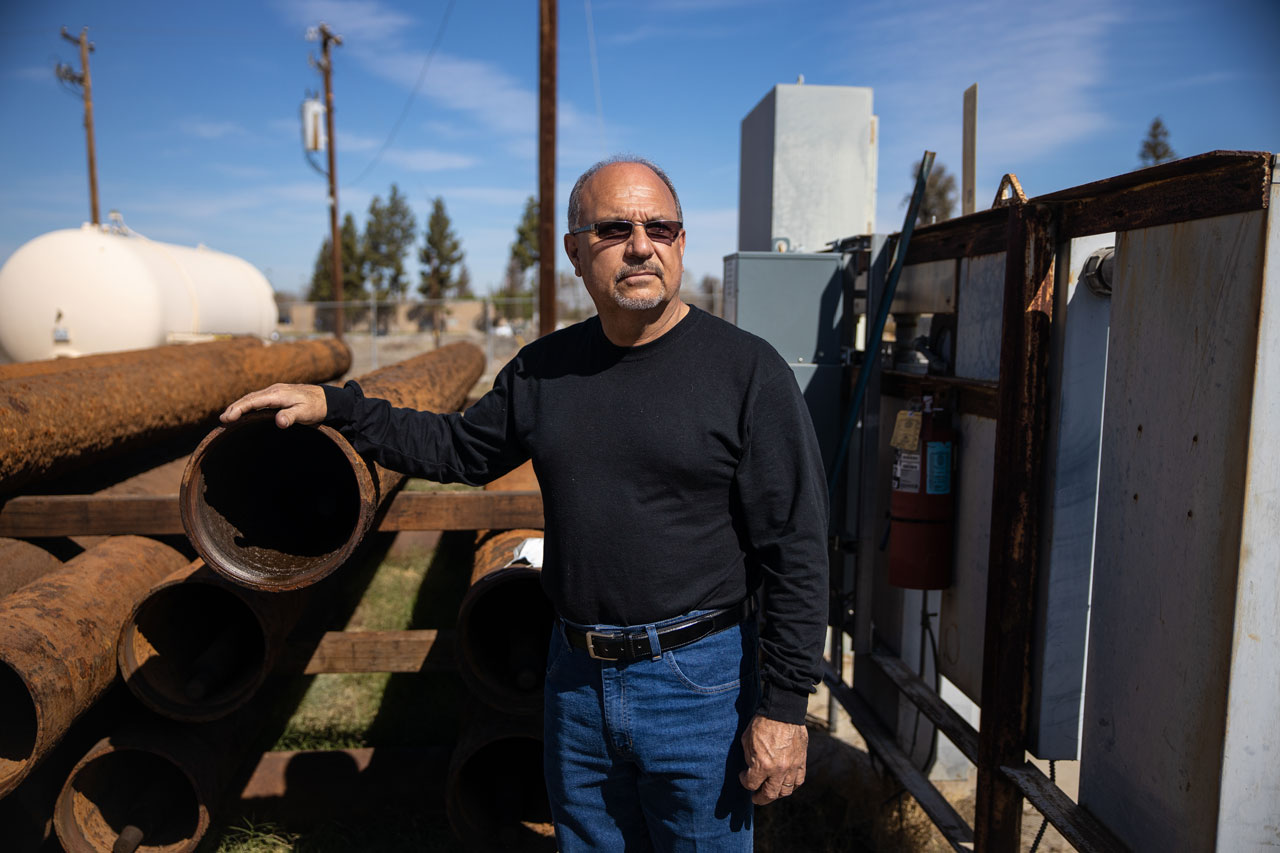
Miguel Sanchez, member of the board of directors of the Lamont Public Utility District at the now-defunct Well #13 in Lamont. It’s one of several aging water wells in the city and in nearby El Adobe.
But Californians now have a reason to be optimistic: A $2 trillion proposal by President Joe Biden to fund infrastructure improvements across the nation, including for clean water, could provide their state with more money for these types of projects. Biden’s plan — if approved by Congress — would include $111 billion dollars in clean water investments. The proposal seeks $10 billion to monitor and remediate new drinking-water contaminants and to invest in small rural water systems like El Adobe’s. The plan also requests $56 billion in grants and loans to upgrade and modernize America’s aging drinking water, wastewater and stormwater systems. Support for low-income communities and communities of color is a big focus of the proposal.
It’s not yet clear how much of the money would go to California. However, Gov. Gavin Newsom has called Biden’s plan “a game changer.”
And Warner, with Self-Help Enterprises, agreed. Right now, there’s not enough state and federal money available to efficiently tackle all of California’s water contamination and infrastructure problems, he said. Biden’s plan “gave me a lot of hope,” he said. “But it’s got to get approved.”
Meanwhile, Susana De Anda, co-founder of the Community Water Center, an environmental justice organization based in Visalia, applauded California’s SAFER program, but said communities need help faster. A short-term solution would be for the state to implement a rate-assistance program for low-income residents who are struggling to pay their water bills, including those who pay for water twice because their tap water is contaminated, she said.
“We want solutions now,” she said. “It’s a huge problem, and we have generations that have been condemned to this reality.”
A street in the Kern County community of El Adobe, California
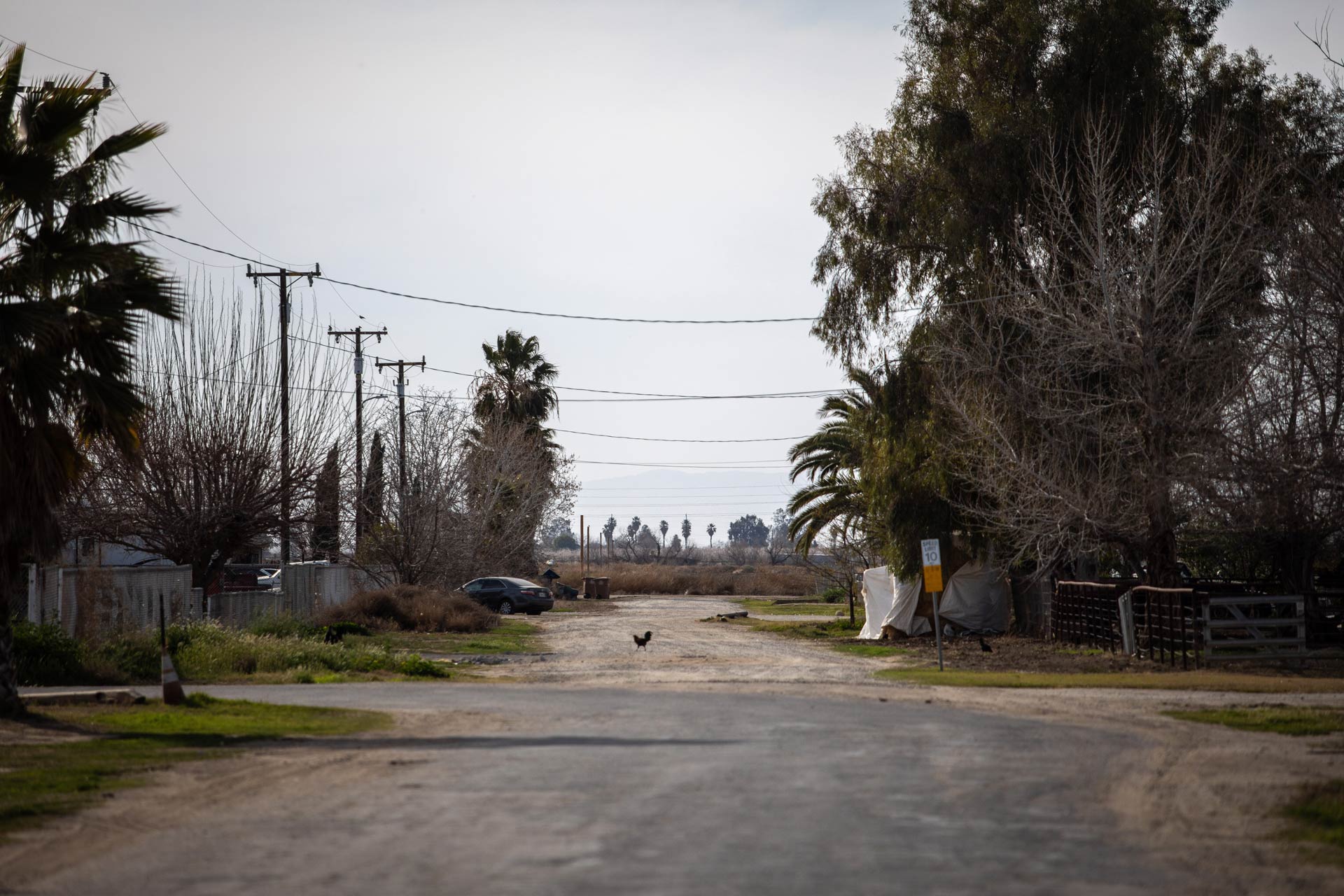
In El Adobe, Hernandez worries that she may be inhaling contaminants or absorbing them through her skin when she showers. The concentration of arsenic in the water is still safe for bathing, according to state regulators, and arsenic does not evaporate into the air, but Hernandez remains distrustful, particularly since she and her husband both have lung problems.
If only officials in Sacramento could spend a day in her shoes, she said. “How would they like it?” she asked. “They don’t have to worry about having a shower, about drinking the water.”
At the edge of the community, Cheryl and Edward Blackhawk checked on El Adobe’s second well, the arsenic-laden one, and its water tank, which sits inside a small enclosure littered with tumbleweeds. Cheryl Blackhawk, who serves as financial secretary for the property owner’s association, said she fears that drought conditions this year will lead to falling water levels that result in higher arsenic concentrations in the well.
Her husband, standing quietly beside the aging pump, confessed he’s beginning to doubt the connection to Lamont will actually happen.
“There’s a lot of people out here who think it’s dead in the water,” he said softly. “And it’s not just us. There are hundreds (of communities) like us in the state.”
Claudia Boyd-Barrett is a senior reporter at the California Health Report. She is based in Ojai in Southern California.
This story was supported by a grant from The Water Desk, with support from Ensia and the Institute for Nonprofit News’s Amplify News Project.
This piece is part of a collaboration that includes the Institute for Nonprofit News, California Health Report, Center for Collaborative Investigative Journalism, Circle of Blue, Columbia Insight, Ensia, High Country News, New Mexico In Depth and SJV Water. It was made possible by a grant from The Water Desk, with support from Ensia and INN’s Amplify News Project.